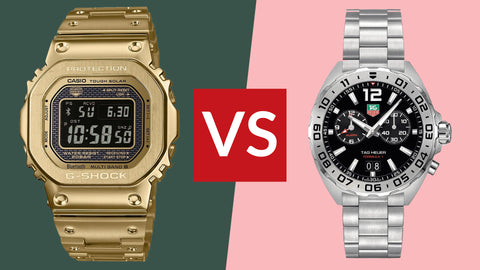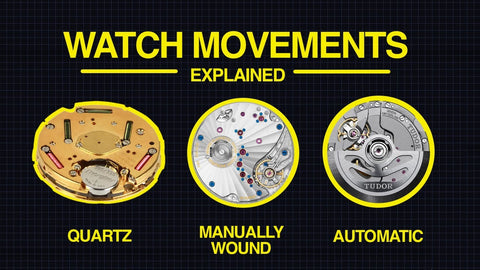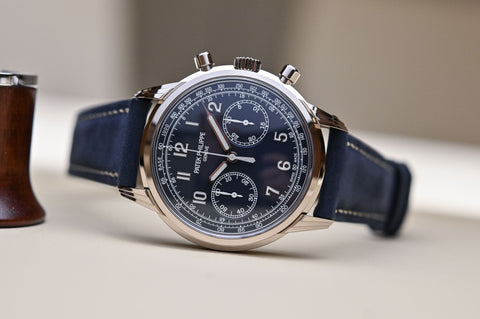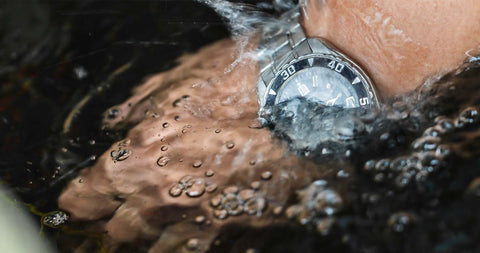Buying a luxury watch is more than just a significant purchase; it's a statement of success, style, and personal refinement. A well-chosen, elegant timepiece reflects not only the time but also the essence of the person wearing it. But, with a multitude of dazzling options, finding the perfect luxury watch can be quite the expedition.
This comprehensive guide aims to navigate you through this thrilling adventure, highlighting key factors to consider when buying a high-end luxury watch. Regardless of whether you're a novice in the world of horology or an experienced collector, this guide will provide valuable insights, ensuring your watch does more than just tick the tocks, but rather proclaims your unique style and success.
1. Watch Dial Types: Digital or Analog?
 Image Credit: www.t3.com
Image Credit: www.t3.com
When embarking on your journey to buy a luxury watch, one of the primary factors you must consider is the type of watch dial. This choice is quite fundamental as it significantly contributes to the watch's overall look and feel.
Generally, watch dials come in two types - digital and analog. Your choice between these two will largely depend on your lifestyle, particular needs, and fashion preferences.
Digital watches offer a modern, tech-savvy, and sometimes sporty appeal. These watches typically display the time in numerical form on an LCD, LED, or similar screen. Some digital watches also come packed with additional features like alarm settings, compass functionality, backlights, and even connectivity to other digital devices. However, despite these advanced features, digital watches might not be the best fit if you're in need of a luxurious and contemporary timepiece for stylish, formal, or business engagements.
On the other hand, analog watches have stood the test of time and have never phased out of the fashion scene. Analog watches, characterized by hour and minute hands that constantly rotate around a staffed dial, are often associated with class, elegance, and sophistication. Their intricate design, craftsmanship, and the mechanical genius involved in their creation contribute to their luxurious appeal.
Specifically, luxury analog watches can be a statement of everlasting style. They allow you to embrace tradition yet express individuality, especially because they come in a vast array of designs, sizes, and styles. From simplistic, minimalist designs to Scandinavian-inspired aesthetics and opulent diamond-encrusted dials, analog watches provide a plethora of options.
Therefore, if you're aiming to emanate a classic and refined vibe with your timepiece, an old-fashioned analog watch is recommended. The ticking of their hands doesn't just tell the passing of time, but it also speaks volumes about your appreciation for timeless style and luxury. And by choosing the right analog watch, you will effortlessly elevate your sartorial game, whether it's for a formal event, an important business meeting, or a posh social gathering.
2. Strap Style: Leather, Metal, Rubber/Resin, or Nylon?

The strap of a watch is like an elegant piece of clothing that enhances the overall look of your timepiece. It not only secures your timepiece on your wrist but also plays a significant role in defining your personal style and comfort.
Leather straps are highly popular, as they offer a timeless appeal and sophistication that meshes well with virtually any style. A quality leather strap can add a touch of class to your outfit, making it an excellent choice for formal occasions or business meetings.
However, it's essential to remember that leather, despite its elegance and durability, tends to wear off with time and is sensitive to environmental factors. In particular, hot and humid weather can damage your leather strap, causing it to crack or discolor. So, if you live in a climate that is often hot or decide to wear your watch during summer escapades, you might consider opting for a more heat-friendly strap.
Nylon straps can be the perfect alternative in such cases. They are known for their durability, comfort, and resistance to heat and water. Although they might not emit an aura of luxury like leather or metal, nylon straps come in an array of colors and designs, providing fashion versatility. Plus, their light and breathable nature make them an excellent choice for active individuals.
Metal straps are another classic choice for luxury watches. These straps exhibit a certain powerful and robust character, making them a favorite for many men. Metal bands like stainless steel, titanium, or even gold are typically hefty and durable – perfect for supporting larger watch faces. Moreover, their shiny finish can bring a sleek and superior look that pairs exquisitely with business or formal attire. Remember, a well-chosen metal strap can become an everyday companion that defines your style.
Lastly, there's the not-so-usual but highly practical rubber or resin straps. Don't be dissuaded by the misconception that rubber straps reflect poor quality. Quite the contrary. Luxury watch manufacturers often use high-grade rubber or resin to provide durable, waterproof, and often sporty strap options. Rubber straps are incredibly resilient, easy to clean, and comfortable, no matter the situation. They can accompany you to the gym, office, or even formal events, blending effortlessly with many attire types.
Choosing a strap type should reflect your lifestyle, comfort, and aesthetic desires. Each strap style has unique characteristics, and understanding these will help you make an informed decision in your luxury watch purchasing journey.
3. Understanding Watch Movements: Mechanical, Automatic, or Quartz?

Image Credit: Montredo
The movement, or caliber, of a watch is its lifeblood. It's a complex mechanism that powers the watch, regulating the passage of time and driving the watch's various functions. Understanding different types of movements can be quite crucial in your luxury watch purchasing journey, as each type boasts its unique merits and characteristics.
Mechanical movements are the oldest type of watch movement and are often found in traditionally styled, often retro-influenced watches. Highly respected for their intricate craftsmanship and artistry, mechanical watches are powered by a series of tiny components, including detailed cogs and springs. These intricate parts work harmoniously to drive the watch hands around the face. One factor to note with mechanical watches is they require manual winding - a daily ritual of winding the crown to power the watch. This ritual contributes to a sense of engagement and a special bond between the wearer and the watch. Moreover, mechanical watches operate without a battery, providing an eco-friendly option. They symbolize not just a love for traditional horlogery but also a nod to self-sustainability and environmental consciousness.
However, if the idea of daily winding doesn't appeal to you, automatic watches will be your perfect ally. Often termed as 'self-winding', automatic watches harness the energy from the natural motion of your wrist and use it to wind the mainspring, keeping the watch running. They marry the intricate beauty of mechanical watches with a touch of modern convenience. One delightful aspect of automatic watches is the sweeping movement of the second hand, which is much smoother compared to quartz or battery-powered watches.
Lastly, if reliability, maintenance ease, and precision are your top priorities, quartz movements are worth considering. Quartz watches use a small, electrified quartz crystal to maintain timing accuracy, powered by a battery typically lasting between 1-3 years. They are reputed for their excellent accuracy, often outperforming mechanical and automatic watches in this regard. Moreover, they require less care and are generally more cost-effective, making them an affordable luxury option.
Each of these movements - mechanical, automatic, and quartz - brings a unique story and charm to your wrist. Therefore, giving close thought to the type of movement that best aligns with your lifestyle, convenience, and watch-amour will enhance your relationship with your timepiece and add extra sparkle to the luxury watch experience.
4. Key Watch Features: More Than Just Timekeeping

Patek Philippe Chronograph Ref. 5172G
Image Credit: Monochrome Watches
Delving into the world of luxury watches also means understanding the numerous features or 'complications' that a timepiece can offer. These features can greatly enhance the functionality and appeal of your watch, tailoring it to your lifestyle, needs, and interests.
Consider how you'll use your watch and the features relevant to you. For active individuals or sporting enthusiasts, a chronograph (stopwatch) could be of great use. This feature can time events and activities to the second, making it perfect for timing laps, workouts, or any event where precise measurement counts. In upscale luxury watches, the chronograph function can go up to a length of 24 hours, offering extended timing options.
Additionally, some luxury watches offer a tachymeter, a scale on the watch's bezel that cooperates with the chronograph function to measure speed over a known distance. If you're in racing, boating or aviation, this could be a captivating feature.
Given our growing connectedness with technology, many high-end brands now offer a combination of classic craftsmanship and futuristic technology in their smartwatches. Smart digital luxury watches can be synced to your smartphone or computer, providing a plethora of handy features. You can have access to notifications, fitness tracking, GPS, and even mobile payments right on your wrist, providing convenience in this fast-paced digital world. However, keep in mind that such watches often need frequent software updates to keep them running smoothly and make full use of their capabilities.
Additionally, some watches offer a dual time or GMT function, which shows the time in another time zone. This complication can be a major advantage if you're often travelling or working across different time zones.
Above all, don't forget to consider the basics: clear and readable dials, durable crystal (the clear cover over the watch face), and a secure clasp. After all, the best watch features are the ones that blend seamlessly with your lifestyle, adding convenience and complimenting your personal style. Remember, a truly luxurious watch is not just about aesthetics, it's about how well its features cater to your needs while exuding elegance and quality.
5. Water Resistance: Not Just a Numbers Game

When it comes to luxury watches, an element not to be overlooked is water resistance. It’s a crucial attribute that ensures the durability and longevity of your timepiece in various environments. However, understanding the true meaning of water resistance in the world of horology can be a bit tricky.
Precisely, no watch is truly “waterproof.” The term "waterproof" implies an absolute, impervious defense against water, which no watchmaker can guarantee unequivocally. Instead, watches are rated for their degree of water “resistance," which simply indicates the level of protection the timepiece provides against water intrusion.
Watches marked with '100m water resistance' mean they have been tested in a laboratory setting and have successfully withstood water pressure equivalent to a depth of 100 meters. However, this doesn't imply that the watch can be worn for diving to such depths. Real-life factors like water temperature, swimming speed, or the age of the watch's seals can affect water resistance.
Therefore, it's crucial to be realistic about your watch's water resistance and your planned activities. For everyday use, light swimming, or showering, a watch with a water resistance rating up to 100m should suffice. But if you plan to indulge in water sports or scuba diving, consider watches offering higher water resistance, specifically designed dive watches which can withstand extreme underwater pressure.
To ensure the continuing water resistance of your watch, you'll need regular checks and maintenance. Over time, the rubber seals that ensure water resistance can degrade, so having them replaced and tested every few years is a good idea.
As for testing, the manufacturer usually provides the water resistance rating. Professional watches may undergo more rigorous testing that includes thermal shock resistance and moisture detection tests.
Understanding water resistance will help you properly care for and maintain the longevity and functionality of your luxury timepiece. So, consider your requirements, but also take the time to understand what the specific water-resistance ratings mean before venturing into waters – literally!
6. Considering Watch Weight: Comfort Meets Style

Audemars Piguet Royal Oak Extra Thin
Image Credit: Teddy Baldassarre
An often-overlooked aspect of choosing a luxury watch is its weight, which can significantly impact your comfort and overall wear experience. The ideal weight of your watch can also be a personal preference and can depend on a number of factors, such as your wrist size, physical strength, and comfort level.
The weight of a watch is typically indicative of its build quality, material, and the complexity of its internal mechanism. High-end watches made of superior materials and complicated movements often carry a certain heft, a sign of their robust build and attention to detail. When worn, this weight can lend a sense of power, prestige, and luxury on the wrist, which can make a significant impression at formal events or professional settings.
However, it's essential to keep in mind that you might be wearing this watch for long hours. Hence, a watch that looks impressive but is too heavy might lead to discomfort and fatigue over time. It's crucial to strike a balance between the weight and comfort of the watch, ensuring it feels 'just right' on your wrist.
Alternatively, if you're the type who prefers a lightweight watch that you can almost forget you're wearing, there are plenty of luxury watches with sleek and slender designs out there. Many brands now use advanced, lighter materials such as titanium or carbon fiber in their constructions for this exact purpose without compromising on the luxury touch.
Whether it's a substantial, sturdy timepiece or a lightweight, slim model, the right weight should ensure maximum comfort while fulfilling your fashion and functional needs. Don't overlook the importance of the weight factor when investing in a precious luxury watch- remember, these timepieces are designed not only to be seen and admired but also to be worn and enjoyed.
Final Thoughts
Choosing the perfect luxury watch is about more than aesthetics; it's an adventure through personal style and fine mechanics. Every element of a watch, from the dial type to its weight, interplay to form an enduring statement of your success, charisma and sophistication. So, when selecting a timepiece, choose one that narrates your own unique story, serving as an elegant extension of your personality.
Buying a luxury watch is a joy unto itself. Appreciate this journey – the thrill of discovery, the satisfaction of owning an exquisite piece of wearable art, the rush of achievement. Remember, with careful selection and proper maintenance, a well-chosen timepiece isn’t just about telling time; it's about commemorating moments, celebrating achievements and even passing on a legacy. Welcome to the captivating world of horology!



Share:
How To Choose Your Watch Band
Top 5 Best Rolexes for Investment